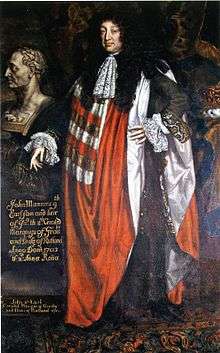John Manners, 1st Duke of Rutland
| John Manners | |
|---|---|
| 1st Duke of Rutland | |
 John Manners, the 9th Earl of Rutland and the 1st Duke of Rutland, oil by Johann Closterman, 1679, Belvoir Castle | |
| Father | John Manners, 8th Earl of Rutland |
| Mother | Frances Montagu |
| Born | 29 May 1638 |
| Died |
10 January 1711 (aged 72) Belvoir Castle |
John Manners, 1st Duke of Rutland and 9th Earl of Rutland (29 May 1638 in Boughton – 10 January 1711 in Belvoir Castle) was a British MP, and Whig politician.
Life
He was the son of John Manners, 8th Earl of Rutland and Frances Montagu. His maternal grandparents were Sir Edward Montagu, 1st Baron Montagu of Boughton and his wife Elizabeth Jeffries. He was styled Lord Roos from 1641 until 1679.
He served, rather passively, as Member of Parliament for Leicestershire from 1661 until 1679. Politically he was a Whig, but did not attend court after 1689, preferring the life of a country magnate.
Lord Roos succeeded his father as Lord Lieutenant of Leicestershire in 1677, and proved an effective deputy of the crown. His invitation to Lord Sherard to stand with him for Leicestershire instead of a gentry candidate upset the Leicestershire gentry, and the Commons disallowed Roos' election. He was created Baron Manners of Haddon on 30 April 1679 and sent to the House of Lords instead, but succeeded as Earl of Rutland on 29 September 1679 at the death of his father. He retained his lord lieutenancy in 1681, despite supporting the Exclusion Bill, but was turned out by James II in 1687. Reappointed in 1689 after the Glorious Revolution, he resigned in 1702, to protest government promotion of Tory interests in Leicestershire. He was briefly Custos Rotulorum of Leicestershire thereafter (22 August 1702 – 22 March 1703). On 29 March 1703, his long support of Whig government was rewarded by his creation as Duke of Rutland and Marquess of Granby. Rutland was reappointed to the lord lieutenancy in 1706, which he retained until his death on 10 January 1711.[1]
Family
He married, firstly, Lady Anne Pierrepont, daughter of Henry Pierrepont, 1st Marquess of Dorchester, on 15 July 1658. The failure of their marriage attracted considerable attention, as divorce was not generally available at the time. He obtained a "separation from bed and board" in 1663 on grounds of her adultery, and private Acts of Parliament in 1667 bastardizing her issue since 1659 and granting him permission to remarry in 1670. This process required considerable expenditure and trouble.
The divorce proceedings aroused enormous public interest and had some political significance since among the regular attenders in the House of Lords was King Charles himself. By his own account he was only there for the entertainment, finding the debates "as good as a play"; but there was a rumour that the King intended to use the divorce as a precedent for divorcing his own childless Queen, Catherine of Braganza. In the event the rumour came to nothing, although the King, who now saw these debates as a useful guide to the opinions of the ruling class, began to regularly attend at the House of Lords. Peers became accustomed to "speaking to the fireside" (i.e. addressing themselves directly to the King, who, to indicate that he was only present as an observer, usually sat by the fire).
He married, secondly, Lady Diana Bruce, daughter of Robert Bruce, 2nd Earl of Elgin, on 10 November 1671. She died on 15 July 1672 in childbed.
He married, thirdly, Catherine Wriothesley Noel (d. 1733), daughter of Baptist Noel, 3rd Viscount Campden, on 8 January 1673 They had three children:
- John Manners, 2nd Duke of Rutland (1676–1721)
- Lady Catherine Manners (1675–1722), married John Leveson-Gower, 1st Baron Gower and had issue.
- Lady Dorothy Manners (c. 1690–1734), married Baptist Noel, 3rd Earl of Gainsborough and had issue.
See also
List of deserters from James II to William of Orange
Notes
References
 Archbold, William Arthur Jobson (1893). "Manners, John (1638-1711)". In Lee, Sidney. Dictionary of National Biography. 36. London: Smith, Elder & Co.
Archbold, William Arthur Jobson (1893). "Manners, John (1638-1711)". In Lee, Sidney. Dictionary of National Biography. 36. London: Smith, Elder & Co. - Morrin, Jean. "Manners, John, first duke of Rutland (1638–1711)". Oxford Dictionary of National Biography (online ed.). Oxford University Press. doi:10.1093/ref:odnb/17957. (Subscription or UK public library membership required.)
| Parliament of England | ||
|---|---|---|
| Preceded by Thomas Merry Matthew Babington |
Member of Parliament for Leicestershire 1661–1679 With: George Faunt 1661–1679 The Lord Sherard 1679 |
Succeeded by The Lord Sherard Sir John Hartopp, Bt |
| Honorary titles | ||
| Preceded by The Earl of Rutland |
Lord Lieutenant of Leicestershire 1677–1687 |
Succeeded by The Earl of Huntingdon |
| Preceded by The Earl of Huntingdon |
Lord Lieutenant of Leicestershire 1689–1703 |
Succeeded by The Earl of Denbigh |
| Preceded by The Earl of Stamford |
Custos Rotulorum of Leicestershire 1702–1703 | |
| Preceded by The Earl of Denbigh |
Lord Lieutenant of Leicestershire 1706–1711 | |
| Peerage of England | ||
| New creation | Duke of Rutland 1703–1711 |
Succeeded by John Manners |
| Baron Manners of Haddon 1679–1711 | ||
| Preceded by John Manners |
Earl of Rutland 1679–1711 | |